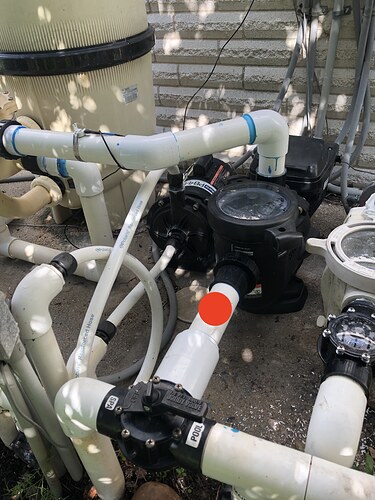I have a pump that is losing prime. I have had a tech out to search for leaks. His recommendation is to add a check valve because the equipment sits higher than the pool. However, we are tight on space and the check valve can not be added without a complete re-pipe. If re-piped and the pump moved further back will cause no room between the pump and wall. I wanted to get your thoughts on this because I feel there has to be another way?
The red dot in the picture is where he would like to add the check valve but there isn’t enough pipe run to add it.
The bottom line: Pool pumping systems are closed systems. There should not be a way for air to get into them. Is this a new installation or an older one? Bad glue joints or threaded fittings can introduce air. Does your filter have a relief valve on the top? Listen to it after you turn everything off for a sucking or burbling sound (the gaskets on these can go bad over time). Be sure all those fittings (3-way valves and your booster pump) don’t have a small leak.
Check our guide on How to Test for Suction Side Air Leaks and How to Identify and Correct Air Leaks for tips on identifying air leaks, and let us know what you find.
InyoRich, thank you for your reply. This is an old installation (2001) however, the pump looks newer and not original. Just bought the house.
I am hearing burbling coming from the manual air relief valve on top of the DE filter when opened. Air leaks have been checked and nothing was found.
I’m being told that because the equipment is higher than the pool that this check valve is required to fix the problem. What are your thoughts on that?
Hi Kea, I’m not buying it. All equipment for every inground pool installed ever (well, 99.99% of them) is higher than the pool. The only reason air would get into the system is if the skimmer is sucking it in because the water level is too low (or maybe the weir door is stuck). I hate to say it, but there is a leak somewhere in the system.
The leak doesn’t have to be in the plumbing - it could be on the pump unions, pump strainer gasket, or on the filter body gasket.
